 |
| View of the Naval Postgraduate School
overlooking Monterey Bay. (Photo Courtesy of the Naval Postgraduate
School.) |
The 19th Annual Review of Progress in Applied
Computational Electromagnetics was recently held on the venerable
grounds of the Naval Postgraduate School in Monterey, CA on 24-28
March. The 'ACES Conference' is a forum for discussing issues
relevant to numerical modeling with emphasis on applied electromagnetics.
Computational electromagnetics (CEM) enthusiasts from the world
over flock to this event each year to learn about the latest and
greatest developments in computer software technologies applied
to an array of electromagnetics problems. These include the prediction
of printed circuit board radiation, the analysis of antenna radiation
effects for large scattering structures like aircraft, radar cross
section, the simulation of antenna coupling for topside deck environments
of ships, and many other types of problems.
The ACES community has also fostered the development of fast solvers
as well as new physics-based methods that adapt Maxwell's equations
in different ways to more accurately and efficiently compute electromagnetic
parameters or "observables" of interest. To accomplish
this requires the marriage of electromagnetic theory, electrical
engineering, computer science, and mathematics. The ACES community
is credited for having helped bring together the respective experts
of these disciplines and providing the focus for blending these
areas together to support the advancement and practical use of
CEM tools. Indeed, the offspring of this marriage of disciplines
are the new computational tools, techniques, and technologies
for the benefit of the electromagnetics community at large.
During ACES' early period, the application of certain flagship
CEM tools that were in fairly wide use at the time and which have
a significant user base even today was emphasized. The range of
problems focused largely on antenna radiation and coupling and
scattering cross section for aircraft and ship problems although
other applications were studied as well. In recent years, the
range of potential applications of interest to the ACES community
has expanded significantly to many other areas and concerns. Today,
the annual ACES conference is considered a prime event for sharing
ideas on the application of CEM technologies to virtually any
electromagnetics problem including EMC. In fact, board-level EMC
is an area of increasing interest within the ACES community.
About ACES
The ACES was organized in 1986. Now formally chartered and incorporated
as a non-profit organization, ACES is an international, inter-disciplinary,
professional society, with a wide range of activities and services.
The interdisciplinary scope of ACES is pivotal to maintaining
a "cross-pollination" between the high-frequency and
low-frequency applications. The primary focus of ACES has been
on computational techniques, electromagnetics modeling software,
and applications of interest to the scientific and engineering
community. Over the years the ACES Conference has been held in
cooperation with various private universities, DoD and DoE agencies,
and professional/technical groups including the IEEE EMC, AP,
and MTT Societies. Support and co-sponsorships have also been
provided to ACES by a number of commercial organizations over
the years.
Applications of interest include, but are not limited to antennas
and their electromagnetic environments, EMI/C, radar cross section,
shielding, EMP, microwave components, fiber optics, electromagnetic
wave propagation, non-destructive evaluation, eddy currents, and
inverse scattering. Interests include frequency-domain and time-domain
techniques, from integral equation formulations to diffraction
theories and physical optics, as well as many of the newer formulations
pertaining to the application of multi-level fast multi-pole algorithms.
ACES activities primarily relate to the following areas:
-
Validation of codes and techniques.
-
Performance analysis of codes and techniques.
-
Computational studies of basic physics.
-
New computational techniques, or new applications
for existing computational techniques or codes.
-
"Rules of thumb" in selecting and
applying codes and techniques.
-
New codes, algorithms, code enhancements,
and code fixes.
-
Input/output issues, which involve innovations
in input (such as input geometry standardization, automatic
mesh generation, or computer-aided design) or in output, input/output
data base management, output interpretation, or other input/output
issues.
-
Computer hardware issues including vector
and parallel computational techniques and implementation.
At the Annual Conference short courses and software
demonstrations are offered. Incidentally, the Annual Conference
has been held on the grounds of the Naval Postgraduate School
or in Monterey, CA proper since its inception. However, this will
change, but more about that later.
In addition to the Annual Conference (with published proceedings),
the ACES activities and services have expanded to include a newsletter,
journal (administered by an international editorial board), and
canonical problem solution workshops (to "benchmark"
the performance of codes and techniques) and code user groups.
In fact, several members of the EMC Society's TC-9 Technical Committee
on CEM are integral participants and contributors on behalf of
the ACES benchmarking activities. Furthermore, a Software Exchange
Committee and a Software Performance Standards Committee, provide
a means of exchanging information about electromagnetic computational
codes and their performance in practical applications spanning
printed circuit board to large, complex system-level problems.
A database is evolving out of the various ACES activities consisting
of computational data to be used for code validation, performance
analysis and optimization, as well as information about particular
codes and techniques. A primary objective of this database is
to establish a "baseline" for the capabilities and limitations
of various codes for different applications, so as to provide
the best possible user guidelines. In addition, the database provides
an informal peer-review mechanism for codes and computational
techniques to facilitate a rapid transfer of useful knowledge
into the mainstream of the numerical electromagnetics community.
Additionally, the Software Committee maintains a small software
library. There are groups within ACES that are researching the
use of artificial intelligence/expert systems and in computational
electromagnetics education.
The ACES membership spans well over 40 countries. There is also
a Chapter of ACES that has formed in the United Kingdom which
has been very active in promoting the advancement and application
of CEM technologies throughout Region 8. ACES chapter development
is being explored elsewhere throughout the world as well.
Worth noting is that the EMC Society Standards Development Committee
(SDCom) has a vested interest in the work of the ACES community
as it relates to the standardization of methods to validate CEM
codes using a set of certified benchmarks. In particular, IEEE
P1597.1 and P1597.2 Working Groups sponsored by the SDCom are
chartered with the development of a Standard and Recommended Practice
for CEM Computer Modeling and Code Validation. The output of the
ACES code validation and benchmark committees will certainly contribute
a great deal towards achieving the goals of the P1597.1 and P1597.2
Working Groups. This coordination will further cement an important
relationship between the EMC Society and ACES in the future.
The current President of ACES is Professor Osama A. Mohammed of
Florida International University in Miami, FL. Dr. Mohammed is
leading the organization down new paths aimed at expanding the
membership base including the development of new chapters worldwide.
Dr. Richard Adler is the organization's internal flame. As a member
of the ACES Executive Committee, Dr. Adler has been there from
the beginning helping to maintain the organization's focus and
direction. He is largely responsible for the administration and
logistical planning side of the annual conference, and is involved
in the handling of membership and financial matters for the organization.
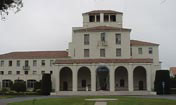 |
| Herrmann Hall, constructed in the
Mediterranean style is host to various technical and social
activities during the ACES Conference. (Photo Courtesy of
the Naval Postgraduate School.) |
On the 2003 ACES Conference
The Naval Postgraduate School has been the primary host location
of the ACES Conference since 1985. One of the historical venues
that has been used to conduct technical and social activities
as part of the Conference each year is the former Hotel Del Monte
on the campus of the Naval Postgraduate School, now known as Herrmann
Hall. The former hotel forms the nucleus of the campus, with its
central building housing the school's headquarters. The Hotel
Del Monte once played host to world dignitaries including Presidents
William McKinley and Theodore Roosevelt as well as royalty, heads
of state, Hollywood celebrities and business tycoons from throughout
the world. The Navy bought the hotel and surrounding property
in 1948 and established the Naval Postgraduate School there in
1952.
The success of this year's ACES Conference was due in large part
to an energetic and hard working steering committee led by Chairman
Dr. Atef Elsherbeni of the University of Mississippi. This year's
conference was an unqualified success and was well attended. Approximately
170 attendees participated this year, which is considered a very
good turnout especially in view of the worldwide political events
of late.
More than twenty individual sessions were held covering the following
topics:
-
Advanced computational techniques for system
design
-
Scattering by complex objects
-
FDTD methods and applications
-
Hybrid techniques in CEM
-
Modeling tools for EMC and signal integrity
problems
-
Finite element methods and applications
-
Time domain numerical modeling beyond FDTD
-
Advances in integral equation techniques
-
Wavelets in electromagnetics
-
Hybrid and coupled time-domain solution
methods
-
EMC design
-
Recent antenna applications
-
EM non-destructive testing
-
Partial differential equation techniques
-
Practical applications of method of moments
modeling.
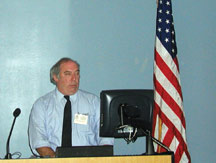 |
| Bruce Archambeault Chairs an ACES
Technical Session on EMC Design. |
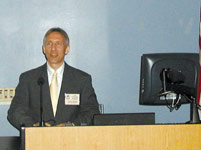 |
| Todd Hubing moderates a Plenary Session
on Industry Applications of Numerical Modeling Tools to EMC
and Signal Integrity Problems. |
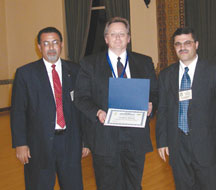 |
|
Osama Mohammed (left) and Atef Elsherbeni
(right) present an award to Andy Drozd in recognition of
services and contributions to the 2003 Conference.
|
 |
| ACES President Osama Mohammed (right)
presents an award to Todd Hubing for contributions to the
2003 Conference. |
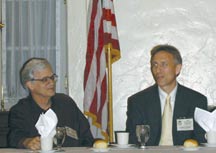 |
| ACES members Jay Rockaway (left)
and Todd Hubing attend the ACES Board of Directors Dinner. |
There was also a special session highlighting
topics on Japanese Research in Electromagnetic Field Computations.
In addition, there were six short courses that were taught including
a hands-on workshop and a series of poster sessions covering a
range of electromagnetic topics. The agenda was rounded out by
a vendor exhibition focusing on the emergence of new CEM software
tools.
Dr. Elsherbeni is also acknowledged for introducing several new
elements to the Conference this year, most notably and for the
first time ever, a live computer modeling and simulation demonstrations
forum. The feedback on this was very good and many have volunteered
to participate in next year's demonstrations. This is similar
to the experiments and computer modeling demonstrations format
that are part of the annual EMC symposia, but on a smaller scale
and devoted more to general CEM problems.
An awards banquet was held on Thursday, 27 March to recognize
the various contributions and support of ACES members including
the award for the best paper. Several of our EMC Society members
who are on the Board of Directors were in attendance and were
there to receive awards. These included Todd Hubing, Bruce Archambeault,
and yours truly among other EMC Society members who were session
co-chairs or panel moderators.
On the 2004 ACES Conference
The ACES organization is looking at holding the annual conference
at different locations in future years. There is a plan presently
on the table to hold the 2004 Conference at Syracuse University
during the mid-latter part of April. I hope to update our members
on the plan as it evolves. The idea is to test drive the conference
at different venues around the US.
I want to encourage our EMC Society members to participate in
the ACES Conference and to learn more about the organization and
membership benefits. To find out more about ACES or to become
a member, go to https://aces.ee.olemiss.edu/.
Dedication
In closing, I would like to dedicate this article to the memory
of Pat Adler, wife of Richard Adler, who unfortunately passed
away after a brief illness during the week of the 2003 ACES Conference.
Those who knew Pat will recall her dedication to her family and
to the ACES organization. She was a tireless supporter of ACES
in every respect and just a real nice person to know. We will
miss her. Thank you for everything Pat! We express our sincere
condolences to the Adler family.
Until next time… EMC
|
|
|
 THE
2003 APPLIED COMPUTATIONAL ELECTROMAGNETICS SOCIETY (ACES)
THE
2003 APPLIED COMPUTATIONAL ELECTROMAGNETICS SOCIETY (ACES)





